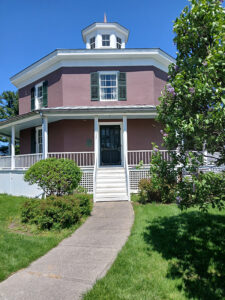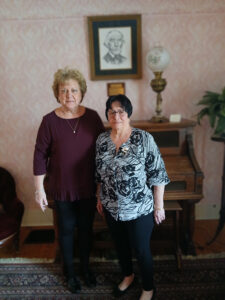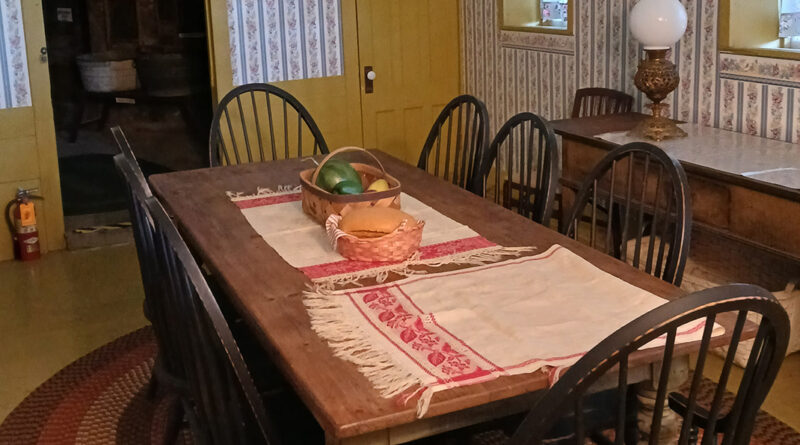The Wilcox Octagon House: An Historical Gem in Camillus
By Tim Bennett

Most of us learn about shapes in elementary school.
Astute readers will quickly think: Octagon. Wow, that’s a house with eight sides! The second thought might be: Why build a house with eight sides?
Great question.
We have to go back to society in the mid-1800s in New York to understand.
Although the octagon structure dates way back to the Greeks as well as the early Dutch pioneers of New York state, one of the strongest proponents of this type of house was the 19th century phrenologist and author Orson S. Fowler, who wrote the book, “A Home For All,” or “The Gravel Wall and Octagon Mode of Building,” in 1848.
In it he listed the benefits of octagon houses. It would cost less to build because fewer materials were needed. It used space more efficiently as compared to traditional houses. It maximized natural light with all its windows and it would cost less to heat because of the reduced exterior surface.
As a result of the book’s popularity, octagon houses were built in more than 20 states in the U.S. and Canada with the majority in New York.
Today, there are 68 octagon houses listed on the U.S. National Register of Historic Places and 15 still standing in the Empire State.
Among them is the Wilcox Octagon House on 5420 W. Genesee St. in Camillus, just west of the Super Walmart.
It was built in 1856 by Isaiah Wilcox who moved to Camillus with his family from Connecticut in the 1840s. When the Wilcox family moved into their new octagon home Isaiah Wilcox was 51, his wife, Ann, 54, his daughter, Mary, 20 and his son, George, 17.

In a recent interview at the site with Karen Donovan, the president of Wilcox Octagon House, and Joy Flood, the first vice president, Flood said, “Mr. Wilcox was what they called a gentleman farmer. This was because he did not work the farm himself but hired local workers to do that for him. He also hired people to serve inside the house, although they did not live there.”
A census from 1855 reveals that the property was a moderately-sized farm, which produced potatoes, corn, wheat, hay, apples and beans. It also had animals such as sheep, chickens, cows, horses and cattle. The census records that the farm consisted of 48 “improved acres” and four “unimproved acres.” Oral tradition says it once consisted of 300 acres.
When asked about the house’s possible use for the Underground Railroad, Flood said, “Although it cannot be substantiated, it is a strong possibility when you consider the proximity of the house to the Erie Canal and Isaiah Wilcox’s abolitionist beliefs. We have a copy of the old petition Isaiah Wilcox signed upstairs that proves he was opposed to slavery.”
The petition Flood is referring to was a public proclamation for all residents who were against the “Fugitive Slave Law” and slavery going “to new soil” [other states], to meet at a local hotel. This law was officially called the Federal Fugitive Slave Act of 1850. This was meant to compel people from any state to return runaway slaves to their owners. The federal consequence of aiding escaped slaves was severe. Those who willingly obstructed, hindered or prevented capture of a fugitive could face a fine of $1,000 ($37,000 today) and up to six months in prison.
Flood said, “This could be why there are no written records of Isaiah Wilcox being involved in the Underground Railroad, if he was. He could have gotten into a lot of trouble for doing this.”
Flood explained how the small door going into the cellar area would have made it easy for escaped slaves to slip in and out unnoticed.
Another case for Wilcox’s possible involvement with the Underground Railroad was the fact many religious people of New York were actively involved. Wilcox was a member of the local Baptist church and served as a deacon. He also wrote to his brother in 1856 urging him to read the book, “My Bondage & Freedom,” by ex-slave, Frederick Douglas.
George Wilcox died young at 23 in 1862, Ann Wilcox at 79 in 1881, Isaiah at 79 in 1884 and Mary at 63 in 1899. Mary continued to live in the house after her father died and never married. She worked as a teacher at the one-room school house in Camillus and became its principal in 1881. She was also very active in the Sunday school and mission projects of her church, The Second Presbyterian Church of Camillus.
After Mary Wilcox’s death in 1899 the Wilcox farm was bought by Edward Fox in 1900. The property was owned by Fox’s family for three generations until 1965, though the farm and house were sometimes rented to outsiders for periods of time. The house was divided into two apartments during the renovations of 1933 through 1935.
The Wilcox Octagon House was purchased by the town of Camillus in 1967 and remains one of its treasured historical museums.
The town takes care of the exterior of the house while the house association is responsible for the interior.
Many renovations have been done since then to return the house to its original condition. Furniture from the time period decorates the rooms as well as framed vintage photos of the families who lived there.
Clothing and other common items of the day are also on display. Regarding a new acquisition for the house, Donovan said, “We were very happy to find a Hoosier kitchen cabinet for downstairs recently.”
This item was popular from 1900 to 1930, produced by the Hoosier Manufacturing Company of Indiana.
Wilcox Octagon House Open for Visitation
Today the Wilcox Octagon House is open on Sundays from April to October for tours and on certain Sundays for special events such as the Father’s Day Strawberry Festival where they sell strawberry shortcake; Farm Day, which features local artisan products; and their popular Christmas event, Holiday Open House, where volunteers creatively decorate small Christmas trees, which are then raffled off.
“We had 600 people come through the house at the Holiday Open House last year,” said Karen Donovan, the president of Wilcox Octagon House.
The Octagon House can also be rented to small groups for bridal showers, teas, art exhibits and special showings.
“One time, an antique car group decided to make The Octagon House a destination point for one of their events. We could not accommodate the whole group of 65 cars, of course. But I suggested they double up and they came and had a great time,” Flood said.
For more information or to schedule a special event at The Wilcox Octagon House, go to: https://octagonhouseofcamillus.org or call 315 488-7800.

